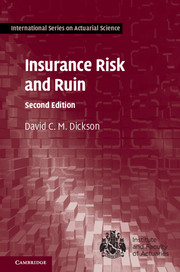Albrecher, H. and Boxma, O. (2005) On the discounted penalty function in a Markovdependent risk model. Insurance: Mathematics & Economics
37, 650–672.
Asmussen, S. and Albrecher, H. (2010) Ruin Probabilities, 2nd edition. World Scientific Publishing, Singapore.
Borch, K. (1990) Economics of Insurance. North-Holland, Amsterdam.
Bühlmann, H. (1980) An economic premium principle. ASTIN Bulletin
11, 52–60.
Centeno, M.L. (1986) Measuring the effects of reinsurance by the adjustment coefficient. Insurance: Mathematics & Economics
5, 169–182.
De Pril, N. (1985) Recursions for convolutions of arithmetic distributions. ASTIN Bulletin
15, 135–139.
De Pril, N. (1986) On the exact computation of the aggregate claims distribution in the individual life model. ASTIN Bulletin
16, 109–112.
De Pril, N. (1988) Improved approximations for the aggregate claims distribution of a life insurance portfolio. Scandinavian Actuarial Journal, 61–68.
De Pril, N. (1989) The aggregate claims distribution in the individual risk model with arbitrary positive claims. ASTIN Bulletin
19, 9–24.
De Pril, N. and Dhaene, J. (1992) Error bounds for compound Poisson approximations of the individual risk model. ASTIN Bulletin
22, 135–148.
De Vylder, F. (1978) A practical solution to the problem of ultimate ruin probability. Scandinavian Actuarial Journal, 114–119.
De Vylder, F. and Goovaerts, M.J. (1988) Recursive calculation of finite time survival probabilities. Insurance: Mathematics & Economics
7, 1–8.
Dickson, D. C. M. (1992) On the distribution of the surplus prior to ruin. Insurance: Mathematics & Economics
11, 191–207.
Dickson, D. C. M., Egídio dos Reis, A. D. and Waters, H.R. (1995) Some stable algorithms in ruin theory and their applications. ASTIN Bulletin
25, 153–175.
Dickson, D. C. M., Hughes, B.D. and Zhang, L. (2005) The density of the time to ruin for a Sparre Andersen process with Erlang arrivals and exponential claims. Scandinavian Actuarial Journal, 358–376.
Dickson, D. C. M. and Li, S. (2010) Finite time ruin problems for the Erlang(2) risk model. Insurance: Mathematics & Economics
46, 12–18.
Dickson, D. C. M. and Waters, H.R. (1991) Recursive calculation of survival probabilities. ASTIN Bulletin
21, 199–221.
Dickson, D. C. M. and Waters, H.R. (1996) Reinsurance and ruin. Insurance: Mathematics & Economics
19, 61–80.
Dickson, D. C. M. and Waters, H.R. (1999) Multi-period aggregate loss distributions for a life portfolio. ASTIN Bulletin
29, 295–309.
Dickson, D. C. M. and Waters, H.R. (2002) The distribution of the time to ruin in the classical risk model. ASTIN Bulletin
32, 299–313.
Dickson, D. C. M. and Waters, H.R. (2004) Some optimal dividends problems. ASTIN Bulletin
34, 49–74.
Dickson, D. C. M. and Willmot, G.E. (2005) The density of the time to ruin in the classical Poisson risk model. ASTIN Bulletin
35, 45–60.
Drekic, S. and Willmot, G.E. (2003) On the density and moments of the time to ruin with exponential claims. ASTIN Bulletin
33, 11–21.
Dufresne, F. and Gerber, H.U. (1989) Three methods to calculate the probability of ruin. ASTIN Bulletin
19, 71–90.
Feller, W. (1966) An Introduction to Probability Theory and Its Applications, Volume 2. Wiley, New York.
Gerber, H.U. (1979) An Introduction to Mathematical Risk Theory. S. S. Huebner Foundation, Philadelphia, PA.
Gerber, H.U., Goovaerts, M.J. and Kaas, R. (1987) On the probability and severity of ruin. ASTIN Bulletin
17, 151–163.
Gerber, H.U. and Pafumi, G. (1998) Utility functions: From risk theory to finance. North American Actuarial Journal
2, No. 3, 74–100.
Gerber, H.U. and Shiu, E. S. W. (1998) On the time value of ruin. North American Actuarial Journal
2, No. 1, 48–78.
Goovaerts, M.J., De Vylder, F. and Haezendonck, J. (1984) Insurance premiums. North-Holland, Amsterdam.
Grimmett, G.R. and Welsh, D.J.A. (1986) Probability: An Introduction. Oxford University Press, Oxford.
Hogg, R.V. and Klugman, S.A. (1984) Loss Distributions.
John Wiley, New York.
Klugman, S.A., Panjer, H.H. and Willmot, G.E. (1998) Loss Models – From Data to Decisions. John Wiley, New York.
Kornya, P.S. (1983) Distribution of aggregate claims in the individual risk theory model (with discussion). Transactions of the Society of Actuaries
35, 823–858.
Kuon, S., Reich, A. and Reimers, L. (1987) Panjer vs De Pril vs Kornya: A comparison from a practical point of view. ASTIN Bulletin
17, 183–191.
Lin, X.S. and Pavlova, K. (2006). The compound Poisson risk model with a threshold dividend strategy. Insurance: Mathematics & Economics
38, 57–80.
Lin, X.S. and Willmot, G.E. (2000) The moments of the time of ruin, the surplus before ruin, and the deficit at ruin. Insurance: Mathematics & Economics
27, 19–44.
Panjer, H.H. (1981) Recursive evaluation of a family of compound distributions. ASTIN Bulletin
12, 21–26.
Panjer, H.H. (1986) Direct calculation of ruin probabilities. Journal of Risk and Insurance
53, 521–529.
Panjer, H.H. and Lutek, B.W. (1983) Practical aspects of stop-loss calculations. Insurance: Mathematics & Economics
2, 159–177.
Panjer, H.H. and Wang, S. (1993) On the stability of recursive formulas. ASTIN Bulletin
23, 227–258.
Panjer, H.H. and Willmot, G.E. (1986) Computational aspects of recursive evaluation of compound distributions. Insurance: Mathematics & Economics
5, 113–116.
Panjer, H.H. and Willmot, G.E. (1992) Insurance Risk Models. Society of Actuaries, Schaumburg, IL.
Picard, P. (1994) On some measures of the severity of ruin in the classical Poisson model. Insurance: Mathematics & Economics
14, 107–115.
Prabhu, N.U. (1961) On the ruin problem of collective risk theory. Annals of Mathematical Statistics
32, 757–764.
Rolski, T., Schmidli, H., Schmidt, V. and Teugels, J. (1999) Stochastic Processes for Insurance and Finance.
John Wiley, Chichester.
Schröter, K. J. (1991) On a family of counting distributions and recursions for related compound distributions. Scandinavian Actuarial Journal, 161–175.
Sundt, B. (1992) On some extensions of Panjer's class of counting distributions. ASTIN Bulletin
22, 61–80.
Sundt, B. and Jewell, W. S. (1981) Further results on recursive evaluation of compound distributions. ASTIN Bulletin
12, 27–39.
Wang, S. (1995) Insurance pricing and increased limits ratemaking by proportional hazards transforms. Insurance: Mathematics & Economics
17, 43–54.
Waters, H.R. (1983) Some mathematical aspects of reinsurance. Insurance: Mathematics & Economics
2, 17–26.
Willmot, G.E. and Lin, X.S. (1998) Exact and approximate properties of the distribution of the surplus before and after ruin. Insurance: Mathematics & Economics
23, 91–110.





